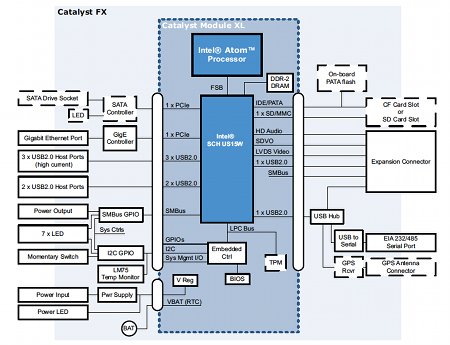Eurotech module adopts 32nm Atom
Feb 1, 2012 — by LinuxDevices Staff — from the LinuxDevices Archive — 6 viewsEurotech announced a new member of its Catalyst computer-on-module (COM) family, this time based on Intel's 32nm “Cedar Trail” Atom processors. The Catalyst CV supports clock speeds up to 1.6GHz, DDR3 memory up to 4GB, 10/100 Ethernet, eight USB 2.0 ports, and four PCI Express x1 interfaces, according to the company.
Eurotech's proprietary, 3.9 x 2.8 Catalyst COM format dates back to April 2008, and has always employed Intel Atom processors, as we review later in this story. The company's new Catalyst CV module adopts one of the 32nm "Cedar Trail" Atoms that were announced by Intel last month, the 1.6GHz N2600.
| Model | Clock speed | Cores/threads | TDP | Price |
| D2500 | 1.86 GHz | 2/2 | 10W | $42 |
| D2700 | 2.13 GHz | 2/4 | 10W | $52 |
| N2600 | 1.6 GHz | 2/4 | 3.5W | $42 |
| N2800 | 1.86GHz | 2/4 | 6.5W | $47 |
Intel's "Cedar Trail" Atoms
Actually, Eurotech's specs cite only an "Atom N2x00 with processor speeds up to 1.6GHz," suggesting more than one CPU choice is planned. But as the table above shows, the N2600 is the only processor that qualifies as of now — we wouldn't be surprised to see Intel adding 1.1GHz or 1.3GHz variants in the future, however.
Intel said in January that the Cedar Trail parts reduce power consumption by up to 20 percent compared to the "previous platform." Graphics performance has been improved, too, according to the chipmaker, with Blu-ray 2.0 support, a dedicated media engine for 1080p playback, and added video options that include Intel Wireless Display, DisplayPort, and HDMI.
According to Eurotech, the Catalyst CV teams the N2x00 processor with the expected NM10 Express, plus up to 4GB of DDR3 RAM. No photo of the device was supplied, but we're presuming its memory is soldered on, as it was with the earlier Catalyst TC pictured below; however, the company's data sheet also refers to "optional SODIMM configurations."

Eurotech's earlier Catalyst TC, the same size as the company's new Catalyst CV
(Click to enlarge)
Eurotech says the Catalyst CV provides a 10/100 Ethernet port, eight USB 2.0 ports, and four PCI Express x1 expansion lanes. Capable of displaying 1080p video and driving dual independent displays, the module is configurable with LVDS, VGA, HDMI, DisplayPort, or eDP interfaces, the company adds.
As usual with modules, the Catalyst CV requires a separate carrier board to convey signals to and from the outside world. Eurotech did not suggest a specific board to hold the device, but we're assuming it's compatible with the existing Catalyst FX product (see later).
According to Eurotech, the Catalyst CV runs Windows 7, Windows Embedded Standard 7, and Windows Embedded Compact 7. Also supported is Wind River Linux with LiveUSB support, "a powerful program which allows developers to effortlessly create applications in the Linux environment much more quickly than traditional methods."
Specifications cited by Eurotech for the Catalyst CV include:
- Processor — Intel Atom N2x00 clocked up to 1.6GHz
- Chipset — NM10 Express
- Memory — up to 4GB DDR3 RAM; "optional SODIMM configurations"
- Storage — n/s
- Expansion — 4 x PCI Express x1 interfaces
- Networking — 1 x 10/100 Ethernet
- Other I/O:
- LVDS
- VGA
- HDMI
- DisplayPort
- eDP
- HD audio I/O
- 8 x USB 2.0 ports
- Power consumption — 7-8 Watts typical consumption
- Operating temperature — -40 to 185 deg. F (-40 to 85 deg. C)
- Dimensions — 3.9 x 2.8 inches (100 x 67mm)
Background
Eurotech introduced its first Catalyst module in April 2008, based on the original Intel Atom Z5xx CPUs, and then released a PC/104-Plus-based Isis carrier board for the module later that year. In March of 2009, Eurotech announced a Catalyst XL version that was based on the extended temperature Z5xxx PT Atom, followed by a carrier board for the XL called the Catalyst FX (below).

Eurotech's Catalyst FX
In December 2009, Eurotech followed up with the Catalyst LP, which moved to the N450 or dual-core D510 "Pineview" Atoms, and added SATA and PATA interfaces, as well as additional expansion buses. Finally, September 2010 brought the Catalyst TC, a module featuring Intel's then-new Atom E6xx.
Eurotech might be planning a revised carrier board for the Catalyst CV, but until we hear different, we're assuming the Catalyst FX is relevant. Measuring 5 x 4.33 inches (127 x 110mm), this device not only houses a Catalyst module, but also adds up to 8GB of flash storage, includes a CompactFlash slot, and allows connection of a 2.5-inch SATA hard disk drive, the company says.

A block diagram of Eurotech's Catalyst FX
(Click to enlarge)
The Catalyst FX also provides a gigabit Ethernet port with RJ45 connector, a DB9 connector for a serial port that is software-switchable between RS232 and RS232/RS485, and five USB 2.0 host ports, according to Eurotech. The carrier board additionally has line audio I/O, according to Eurotech.
On its own, the Catalyst FX does not provide any video outputs, but available expansion boards can add VGA, LVDS, HDMI, or DVI video outputs, according to Eurotech. A GPS receiver based on U-Blox technology is also available, the company adds.
Further information
According to Eurotech, the Catalyst CV will be available during the second quarter of this year for an undisclosed price. More information may be found on the Catalyst CV product page.
Jonathan Angel can be reached at [email protected] and followed at www.twitter.com/gadgetsense.
This article was originally published on LinuxDevices.com and has been donated to the open source community by QuinStreet Inc. Please visit LinuxToday.com for up-to-date news and articles about Linux and open source.